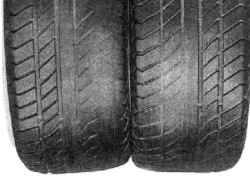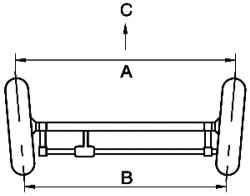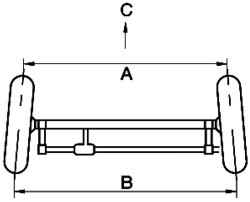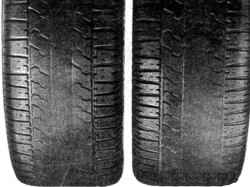 printable version printable version
One-sided wear
The reason for the unilateral wear in many cases driving style, but sometimes incorrect wheel alignment.
Increased lateral wear
Side wear, often in combination with rubbing on the edges of the tread and thin cuts, always occurs when the tire works at extremely high angle of slip and, therefore, "tinder" in the road surface (Fig. 4.6). Fast riding abound turns results in particular areas on the outer shoulders of the tire to increased wear. Rounded outer tire shoulder with a high degree of wear of the outer tread blocks talking about fast driving in turns. Such wear is obtained due to the appropriate driving style. To optimize the driving performance chassis is tuned to certain parameters toe and camber. If the tires are operated at non-specified conditions, must be regarded as a one-way, and increased wear. Especially wrong parameters axle measurement may lead to more one-sided wear, besides increasing the risk of uneven wear.
Negative toe
The distance between the front wheels - A is greater than distance B behind (C direction).
The convergence or toe-
The distance between the front wheels of A is less than distance B behind (C direction). To avoid a unilateral tire wear, care must be taken so that the wheel alignment is always within tolerance automaker. Most often, the angles of the wheels deviate from the nominal values due to external influences, such as a hard contact with the curb when parking. When axle measurement can determine whether the wheel alignment is within tolerance, or they must be adjusted.
Changes to the chassis Using "kit truncated springs" and / or alloy rims, VW is not permitted, it can lead to the angles of the wheels, which differ from the inherent structure. Even if the angles of the wheels at the time when the vehicle is stationary axle measurement is normal, due to changes in the height and position of the wheels in motion can change the nature of the suspension movement of the wheels. Thus, uneven wear is preprogrammed.
Depreciation center of the tread This wear pattern is shown on the driving wheels of cars with powerful engines, which are often long distances at high speed. At high speeds, the tire diameter due to centrifugal force is increased in the middle of the tread is greater than at the edges. Consequently, the driving force is transferred to the road surface from the middle portion of the tread. This fact is reflected in turn in the character wear. Particularly noticeable such wear is shown on wide tires. By reducing the air pressure in the tires to avoid such deterioration will not succeed.
ATTENTION For safety reasons, in any case, do not reduce the air pressure in the tire below a prescribed. |
More or less uniform wear can be achieved through the timely transposition wheels leading to the non-driven axle.
The increased tread wear
A typical pattern of wear of tires mounted on the drive wheels of the car with a powerful engine (Fig. 4.9). Longer wear of the tread the middle is a consequence of tire loads arising due to the centrifugal force of the tire and transmitting the driving force to the road surface.
| 







